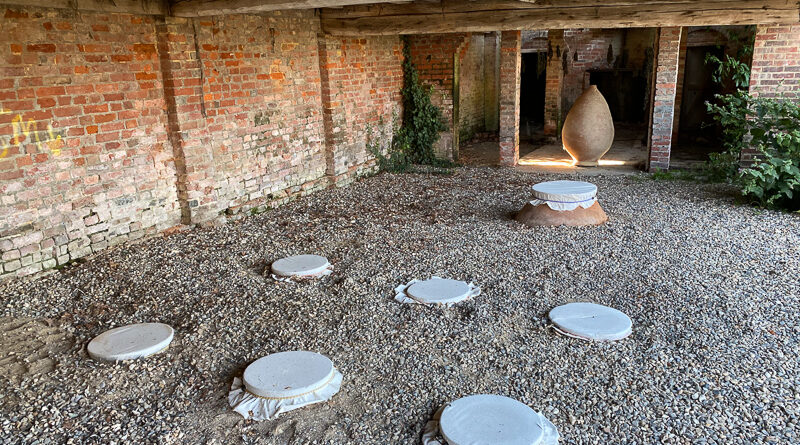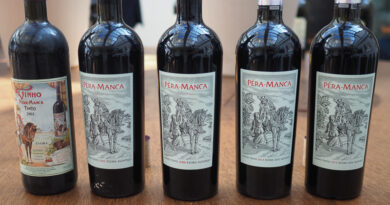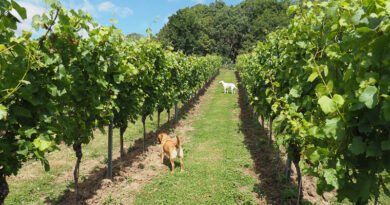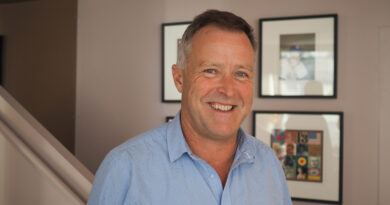Tillingham: visting the winery leading the charge for natural wine in the UK
It’s a sunny day in July, and my first time out of London since lockdown. I’m heading to Tillingham, a new winery in East Sussex that was established by Ben Walgate. It’s distinction is that it’s one of the few natural-focused wineries in the UK, and while traditional method sparkling is made here, it’s the still wines that are the main emphasis. Walgate has planted a vineyard here, which in 2020 will give its first crop. So far, though, he’s been buying grapes from vineyards in Sussex, Surrey, Kent and Essex. Such is the paucity of organic viticulture in the UK, these grapes are conventionally farmed – so, in natural wine terms, this is the only weak link in the chain.
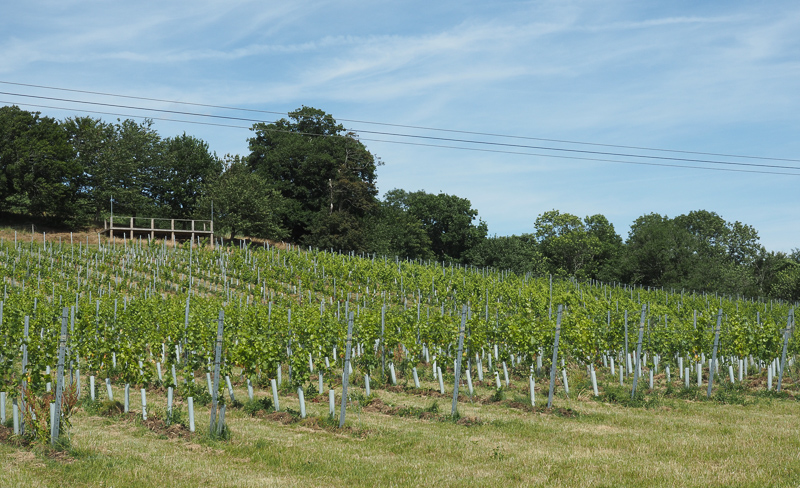
It also happens to be the first day of food service here since lockdown. As well as offering winery and vineyard tours, Tillingham have a pizza oven, and a really attractive outdoor space. 81 people are booked and the sun is shining. The Tillingham restaurant, which offers a tasting menu, and is open Thursday to Sunday, is about to open the following week, as are the 11 rooms that they offer. As well as the Tillingham wines, they also offer a wine list of mainly natural bottles from elsewhere. It’s a really small operation.
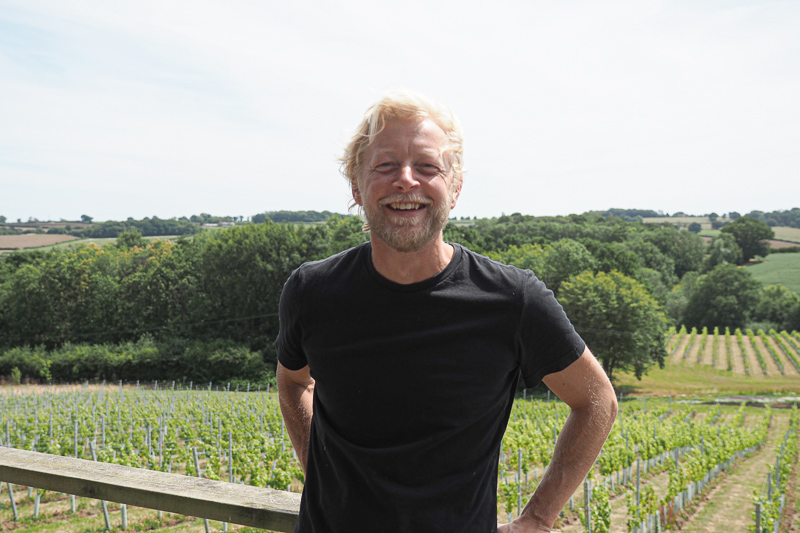
The story
Ben Walgate grew up on a farm in rural Lincolnshire. ‘This was hugely significant in my upbringing,’ he says, ‘just having this connection with the land. I never really thought about this until fairly recently when I had my own farm, how at ease I feel with it all.’
Through school he worked in restaurant and wine bars, and then when he moved to London for college he worked at Majestic. ‘To see new world wines, Marlborough Sauvignon and stuff like that, it was a bit of a revelation. I got really interested.’
Walgate studied classics and ancient history, and kept working in restaurants and bottle shops. ‘I got to the end of university and didn’t know what I wanted to do with my life, but the one thing that hadn’t gone away was wine.’
So he bought one-way ticket around Europe, and a family friend in the hotel business put him in touch with lots of vineyard owners. He set up stages for Walgate to do while travelling around Europe. This included Albert Bichot in Bourgogne. ‘That was an eye opener,’ he recalls. ‘They were industrial: three million plus bottles of wine.’ But he found it instructive to spend a few days with their winemaker tasting all the different wines.
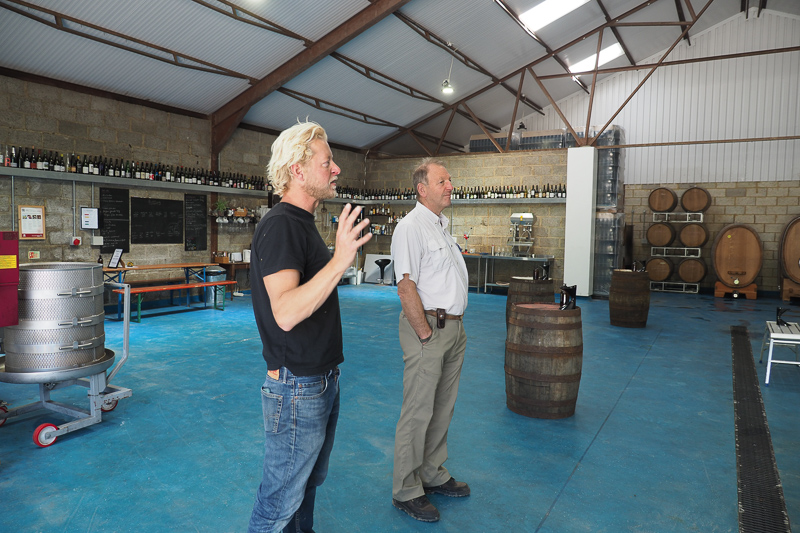
Another visit was with a friend of a friend who had just taken over a family domaine in Volnay, and had decided to take it in a more natural direction. ‘He knew that the soils were washing away down the hill and there was no topsoil left. He cound see there was no future in that. Now he’s incredible – he’s almost fully horse drawn, and makes his own sulfur dioxide from elemental sulfur.’
Walgate spent a couple of weeks there doing back breaking work in the vineyards, and working in the cellar. ‘I absolutely loved it. I thought: this is it.’ He was hooked.
He thought about studying viticulture and enology at Dijon, but it was too expensive and his French wasn’t good enough. So instead he went and studied at Plumpton. This was back in 2004. ‘I dropped out in the second year,’ he says. ‘I was too impatient and it was moving quite slowly.’
He thought about buying a vineyard and even went to look at a few in France, but decided against it. ‘It scared the shit out of me,’ he said. ‘I might get it right in the vineyard and the cellar, but how the hell is anyone going to know about me and want to buy my wine. Distribution seems to be the thing where people fall on their asses.’ He had friends who’d bought vineyards and they’d had a hard time selling them.
So instead he set up his own business importing wine in order to figure out how it all worked, what people were buying and how he could succeed as a producer.
He imported organic and biodynamic wines. ‘I toiled away for 3-4 years with a little shop in Brighton and a warehouse.’ He was importing from eight growers and buying stuff through agencies, and mainly selling wholesale.
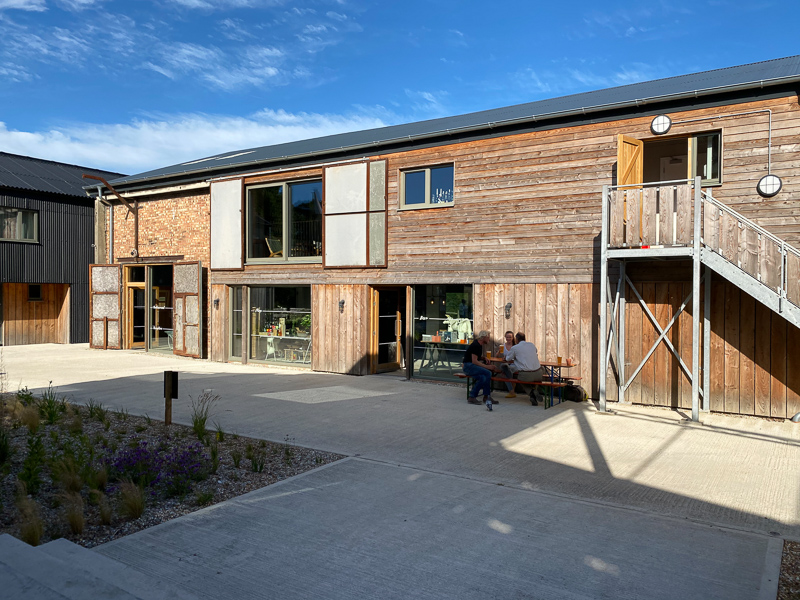
The credit crunch hit in 2008 and he had to wind up the business. ‘It was pretty stressful. I’d just had my first kid.’ Very luckily, Nick Mason and his wife who had also set up an import business took Walgate on, and he took his clients with him. He worked with them for a year. ‘By then I was well and truly fed up with flogging wine: my goal was always to be in production.’
He took a job on a vineyard on the Isle of Wight, which he describes as pretty decrepit. There were some 1960s plantings of Seyval Blanc and Rondo. ‘They made one bunch per vine,’ he says. ‘The owners were more interested in their tearoom and B&B.’ The wine wasn’t good. ‘Localism can hide a myriad of sins.’
He renovated the winery and fixed things up. He built a sprayer and started restoring the vineyards, harvesting 15 tons in second vintage. He was mentored by the winemaker of the previous owner who was semi-retired. ‘She held my hand a bit with some of the stuff in the winery.’ He went on a biodynamic agriculture course and started applying what he’d learned, and even planted some vineyards. ‘It was great, but it was never going to go anywhere,’ he says. ‘It was really badly paid, and I managed to have another two children while I was there.’
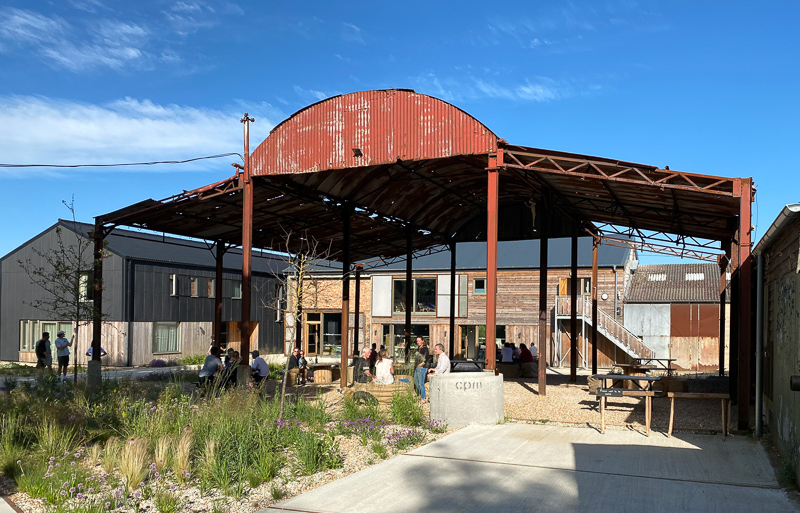
The next stage came through a friend of Walgate’s stepdad who wanted to invest in English wine. They met at a wine bar in Clapham, and got one well. ‘He said, right, you’re our guy; we are going to back you. Just find us an opportunity in English wine.’
Walgate went searching, starting in Sussex, on the downs. ‘I found a farm, and was going to plant 20 acres of vines and do some agritourism.’ They were getting really close to doing it and sadly the guy who was backing him passed away. ‘The strategy changed and we looked to acquire another vineyard.’ They ended up buying Gusbourne, which is how Ben ended up there. ‘It was definitely the right move, and was already making amazing wine. We put together a team, including Charlie Holland as winemaker. John Pollard the vineyard manager was already there.’ They grew significantly, rebranded it, and relaunched it. ‘This was a huge journey.’
‘But this was getting bigger and bigger, and I was getting hands dirty infrequently.’ In Summer 2016 when the cool climate wine symposium was on in Brighton, he went for a beer with his friend Simon Woodhead from Stopham. Walgate explained his dissatisfaction, and Woodhead recommended he check out a farm near where Walgate lived. ‘There was this guy called Terence Kearley who was desparate to plant a vineyard.’ Kearley’s 1000 acre Peasmarsh Estate included Dew Farm, which is where Tillingham is now based. Kearley – also known as Viscount Devonport – really liked the proposal that Walgate made, and saw the 70 acre semi-derelict contract-farmed Dew Farm as an ideal location for the project.
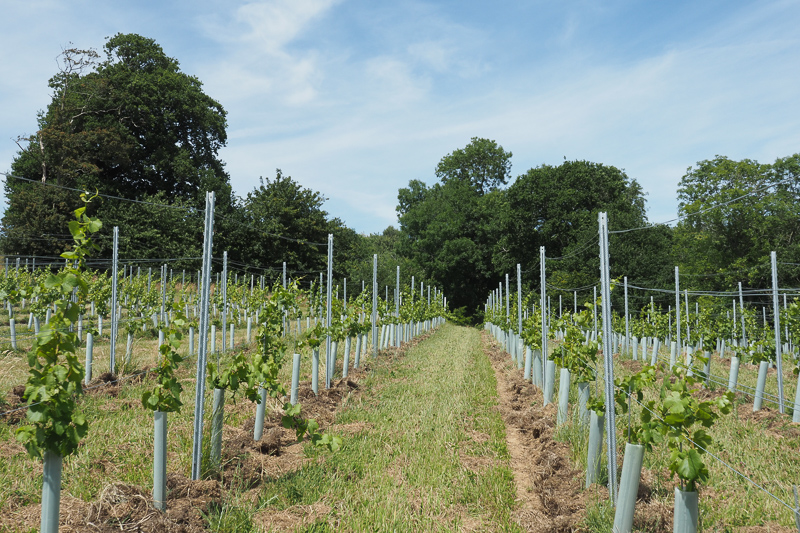
So far, all the Tillingham wines have been made from purchased grapes. ‘They have all been bought in,’ says Walgate. Has he been able to get any organic grapes? ‘You can imagine how hard it is. There are about eight certified organic vineyards I know about in the UK. Very few of them sell. There is one grower we use who is Demeter certified over near Bristol. The 2019 rosé we made from his grapes will be certified organic, but there are only 500 bottles. Then we have one vineyard down the road, and they are self-taught with a couple of acres. We have Schönburger and Phoenix (which is a PIWI). Everyone else is on a scale of being conventional.’ He adds, ‘Strategically it has been a very good thing buying grapes rather than waiting three or four years twiddling our thumbs.’
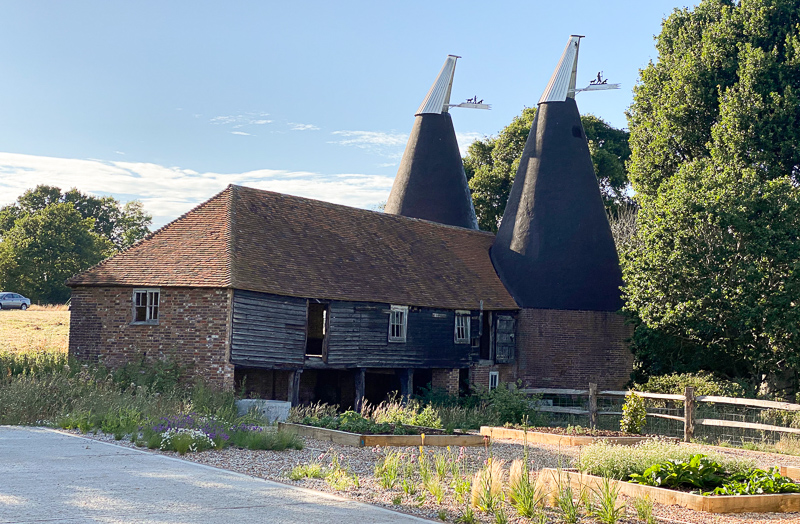
Technically, the soil is called Ashdown beds, and it’s a series of mudstones, sandstones, ironstones with clay over the top. On the flat bits we have issues with drainage, and on the slopes you get the geology poking out.’ We went for a scramble through the woods and into a small ravine, to see the soil and bedrock in section.
The grape varieties planted
He planted 10 000 vines in 2018 and another 30 000 plants in 2019. There are 21 different varieties, but with clonal variations there are actually 32 (for example, there are five Pinot Noirs, four Chardonnays and two clones of Pinot Gris). Walgate said he always wanted to do more still than sparkling. ‘I knew from buying Dornfelder and the Germanic varieties that year-in, year-out, you will be able to do something on the still wine category.’ With Chardonnay and Pinot Noir he could make still wines in some years, but in other years he might want to do traditional method sparkling with them. Across the Germanic varieties, he has Orgtega, Muller Thurgau, Schönberger, Regent, Faberrebe and a few others. Then there’s Pinot Noir, Chardonnay and Pinot Meunier. And then Pinot Gris. In the second year he planted some Pinot d’Aunis and also Gamay. There’s a bit of Chenin Blanc on an experimental block called Copp’s Bank, which is quite sheltered. The experimental varieties are in quantities of 150-250 vines. ‘From a management point of view it is putting a huge burden on the vineyard team,’ says Walgate. ‘Then down the bottom there is some Manzione Bianco and Trousseau. It does seem like folly, having so many cuvees, but it has worked so well for us. The fact that the vines are small production means they are fun to make and there is not too much pressure with the winemaking. It also makes the wines inherently scarce.’ The small batch approach has resulted in 45 wines in three years.
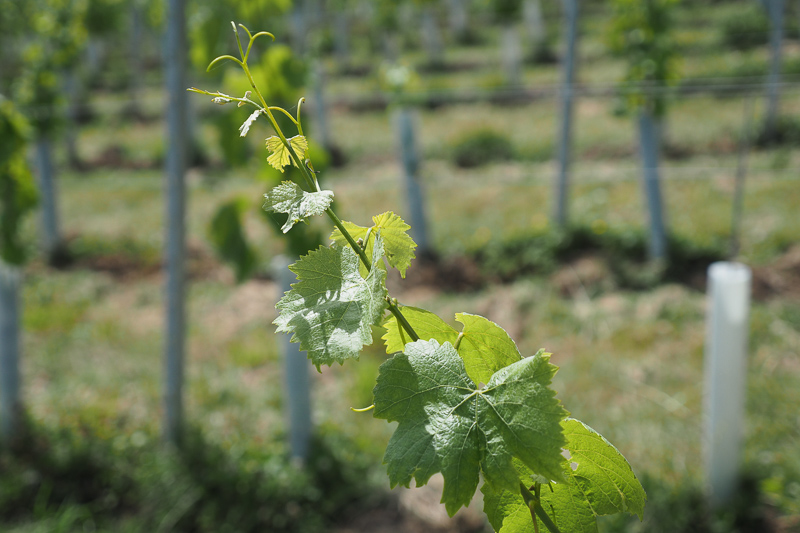
Establishing young vines
Establishing vines is a challenge when you are farming organically. Some begin with herbicides to keep the soil clear so that the young vines can get going without any competition, and then stop using and convert to organics later. Walgate has gone organic from the outset, and says that this site has a lot of invasive weeds, so he planted cover crops in the new vineyard to compete with these native weeds. ‘Where we planted cover crops, we got much less of the invasive weeds growing back,’ he says. But for one part of the vineyard they made some terraces to make it easier to work the slope. ‘Then when we wanted to sow with cover crops it was too late and too wet, so we left it,’ he says. In just the bare earth, the vines grew much faster. ‘The vines grew like triffids and this year you can see the difference. The 15 rows with no cover crops are 12 feet tall, and the ones with cover crops are about four or five feet tall.’ But this bare earth portion soon grew weeds. ‘There are walls of thistles and docks and nettles, but where there are the cover crops, there is very little weed growth,’ he says. ‘Competition is critical when you plant a vine, for the root establishment and allowing the vine to get on. The biomass from the phycaelia and clovers just overwhelms the vines. Our vine establishment where we had the cover crops wasn’t anywhere near as good as it could have been, but you just have to take a long-term view. The problem is, you think, how quickly can I get grapes? I need to get into production as fast as possible. Otherwise you need to borrow more money.’
Young vines are also easy to damage, so you can’t use most of the regular weeding tools.
‘During establishment, until you have a decent trunk, your options are very limited,’ says Walgate. ‘The roller hacker is OK, but for me, the best one – because there is so little disturbance – is the retractable side hoe. It slices under the roots then retracts under the vines. That way you are not disturbing the soil ecology. Our soil is well suited to this.’

Sprays
As well as spraying copper and sulfur, they augment these by using plant-based concoctions such as nettle, horsetail and chamomile tea. ‘We also use essential oils,’ says Walgate, who had a girl working with him who’d done a project on this at Plumpton. Lavender essential oil is used at the beginning of the season as a disinfectant with antimicrobial properties, and he’s also used BD500 on the soil and also as a foliar application. ‘I quite like the idea of using compost teas, just to build up the diversity of microbes in the vineyard.’
They have started making their own mozzarella for the pizza oven out of organic milk. Hundreds of litres are required each week, and about 60% of this is discarded as whey, and this is supposed to be really good for powdery mildew. ‘We are storing this and when we have enough we will put it on,’ says Ben. He is also using Maxicrop, a seaweed-based foliar spray. However, he hasn’t been able to use Trichoderma-based sprays because these are currently banned in the UK. ‘We used it once in 2011 on a vineyard I had pruned, but I think it has lost its approval in the UK because WineGB didn’t lobby for it.’
‘It’s going to be patchy, the first harvest,’ says Walgate. ‘But I’m hoping for around five tons.’
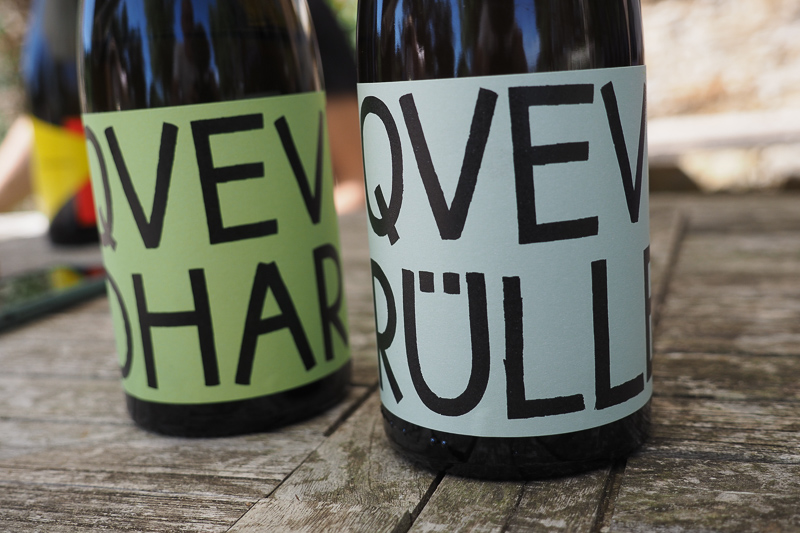
THE WINES
Tillingham Pinot Blanc 2019 England
Carbonic maceration then pressed to barrel (80%) and qvevri (20%). Lovely saline palate with fine-grained texture. This is pretty and expressive, with lovely purity to the fruit and some bright spiciness, with good but balanced acidity. Has slight toasty, mealy undertones. Very fine. 93/100
Tillingham Pinot Blanc 2018 England
Whole bunch pressed to steel, qvevri and oak. Lovely keen acidity here with good spice and herb notes. There’s a mealy quality and a bit of spice. Has a savoury edge. There’s quite keen acidity here with freshness. Has a hint of mealiness and maize that suggest a touch of mouse. 91/100
Tillingham Qvevri Rüllem 2018 England
This is Müller Thurgau. 100% skins in qvevri. This is a little bit cloudy, and a golden orange colour. It has real freshness and flavours of spice, lemons, herbs and a touch of marmalade with good structure. This has a lovely freshness and lots of detail, and really good balance. 94/100
Tillingham Qvevri Dark 2018 England
100% Chardonnay. Two lots – one chalk, one clay. Destemmed and macerated, one 10% skins, one without. 6 months in qvevri and 6 months in barrel. 11% alcohol. This has nuts, spice and honey with good acidity. Very nice texture to this wine, with a lovely linear drive. Very fine. 93/100
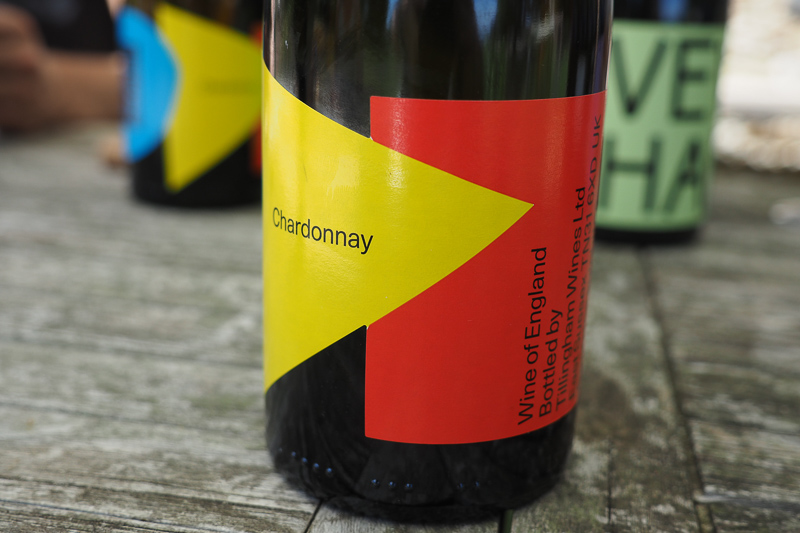
Tillingham Chardonnay 2017 England
Woodchurch vineyard, clay soils. First vintage. Foot-treaded, then pressed to a second use barrel, wild ferment, 20 ppm sulfites at bottling. Lovely aromatics with some oak, meal and spice as well as refined citrus fruit. The palate is intense and lemony with lovely oak character meshing perfectly with the precise fruit. So linear and refined with real precision. Could develop nicely for the next few years. 93/100
Tillingham Chardonnay 2018 England
Chalk site in Surrey. 5 tons of fruit. Sorted the fruit, and it was all immaculate. Took the ripest bunches, and foot trod these into a bin, 24-48 h maceration, then basket pressed to barrel. This is ripe and has some tropical characters with nice spiciness and a mineral streak. Vivid and expressive with a touch of grapefruit, too. Real finesse but also quite ripe and exotic. 92/100
Tillingham Flor 2018 England
12% alcohol. This is Pinot Blanc from Essex (London clay soils), with no filtration or fining, and just 20 ppm sulfur dioxide added. Fermented in stainless steel, then goes to barrel for 9 months, not topped up. A layer of flor develops, and the wine was bottled using inert gas and gravity from the barrel. There’s a delicate flor character on the nose: this has a tangy, citrussy edge to the subtle bread and toast notes, along with some floral hints. The palate fine and fresh with mandarin and lemon notes, as well as a touch of toastiness. There’s a crystalline, saline character too. Just enough flor character to add profundity, without too much. Such a beautifully constructed wine. One of England’s finest still wines, I reckon. 94/100
Tillingham Traditional Method 2017 England
50% Pinot Noir, 45% Chardonnay, 5% Pinot Meunier. Some lots were whole bunch pressed in a pneumatic press, and others were crushed, destemmed and macerated and then pressed in a basket press. Wild ferment then aged on lees for a year. No dosage or fining or filtration, and minimal sulfur dioxide. This is a lovely focused sparkling wine with keen acidity, but also lovely ripe pear, peach and apple fruit, as well as some cherry notes. This is zesty and delicious, with lots of flavour. There’s good acidity, but it never sticks out, and after the first wave of fruit it starts vivid, then expands beautifully on the finish. It’s not trying to be Champagne, but has its own personality, combining ripe, rich flavours with brightness and juicy acidity. The lack of dosage doesn’t create a harsh, austere wine as it so easily could, and I think this is really quite special. 93/100
Tillingham Pinot Noir 2019 England
10.5% alcohol. Tricky vintage, GM2013 clone, got half a ton. One barrel. So supple and fresh: this had a bit of foot treading and then hand pressing the cap down, just 3 d maceration. Very light and delicate, this is floral and supple with sweet plums and cherries. So supple and expressive with red cherry and a bit of pear. Has a touch of redcurrant, too. So lovely. 93/100
Tillingham Pinot Noir 2018 England
13% alcohol. Pigeage twice a day, mix of wood and barrel. More extraction, and riper grapes, and the barrel is a bit newer than in 2019. Sweetly aromatic with a smooth, ripe cherry character and also a hint of cocoa. Ripe, sweet and very fruit with a nice fleshy character. Very drinkable and supple. 91/100
Tillingham Qveri Pinot 2018 England
Press wine with 10% skins in qvevri. Didn’t go through malolactic. No sulfites at all. This has some almond notes and a bit of phenolic spiciness, with some minty notes. Has some grip and a nice chalky edge, with good acidity. Lovely grip here: very expressive and delicious with lovely depth. 93/100
Website: https://tillingham.com/
UK agent: Les Caves de Pyrene
Find these wines with wine-searcher.com

